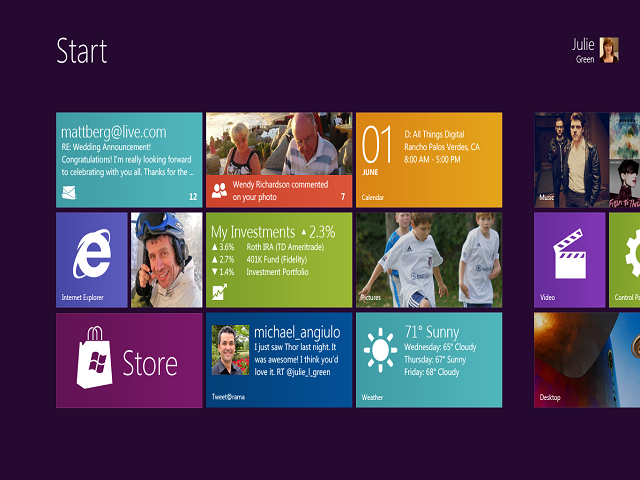Microsoft released the first screenshots of its new next generation operating system Windows 8 on Wednesday. The new platform has been designed right from scratch and is most probably the biggest visual overhaul the Windows OS has gone through since Windows 95. The glimpse revealed a lot about the new direction that Microsoft is trying to take with the Windows brand and the influences which have shaped this new touch screen and tablet friendly product. It has already been said by the software giant over the course of the last few years that their goal with Windows 8 will be to make it more suited towards touchscreen interfaces and tablets than the previous Windows editions as the company believes that this is where the future of computing now lies. Windows President Stephen Sinofsky says that it is not a compromise with the functionality and usability of Windows as users have come to know it, but a much more versatile interface which offers more to the users across a range of platforms.
The heart of the all new interface flaunted by Windows 8 is a redesigned start screen. It is no longer the windows button on the bottom left hand corner of the desktop which opened a menu list, the new start screen is based on the tile based interface which is used in Windows Phone 7 and focuses on making the icons, or tiles, more informative and condensed. All programs of the users are visible as tiles on this screen and they can be accessed quite comfortably by the touch of a finger, or a click of a mouse depending on the machine the OS is running on. Another major change in the platform is the support for two kinds of applications which will run on it. The first are the standard windows applications which run over the desktop, the applications running on all current Windows platforms come under this category. The second type resembles the apps which run on mobile platforms such as Windows Phone 7. These apps are written in Javascript and HTML5 and fill up the whole screen when they are run. Windows 8 will include the new Internet Explorer 10, which has already been configured to run as an app, along with many other widget-like apps which perform tasks like checking email, weather and social networking updates.
Microsoft has worked on the classic design of the Windows desktop to make it friendlier for touch optimized hardware. It includes a new kind of “fuzzy hit targeting” which is designed to adjust for the fact that fingers lack the precision of a mouse. The chief designer Julie Larson-Green says that the purpose behind this is that even as classic apps are designed for the keyboard and mouse combo, they also work well with touch. She said that those apps which take advantage of the new programming layer are designed with touch as the first priority but they will also work quite well with a keyboard and mouse.
Microsoft did not follow up the revelation of the new operating system with any other details; however the start screen which was displayed on Wednesday showed a very noticeable link to a store. This more or less confirms the plans of Microsoft to emulate Apple in the direct distribution of its programs from its own store. Apple already does this for its iPhone, iPad, iPod Touch and Macs with the App Store. Even Sinofsky admitted that Apple’s iPad had shown that there were quite a lot of features missing from Windows, such as a touch first interface and a mechanism for the distribution of apps. The design of Windows 8 claims to tackle all of these issues in its quest of matching Apple’s growing might in the business. However Microsoft will not let go of the essence of Windows Operating Systems in their attempts for change; compatibility with the existing Windows programs will be preserved in the upcoming editions of Windows.

